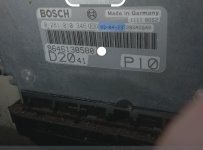Izzys Owner
Member
Hi All,
Fuse 11 in the engine compartment takes about 4 seconds to blow when the ignition is switched on. It says it's one of the fuses for the engine control unit but the only effect is to stop the speedo and odometer working. The red engine warning light comes on but everything runs ok apart from the speedo. This happened in the wilds of northern Scotland and I've done about 700 miles since to get home with no other problem (currently using satnav for speedo).
I temporarily replaced the fuse with a piece of 5A wire to see how it blows and you could see it slowly warm up before it blew, so not a short circuit. Anyone heard of this fault before?
Fuse 11 in the engine compartment takes about 4 seconds to blow when the ignition is switched on. It says it's one of the fuses for the engine control unit but the only effect is to stop the speedo and odometer working. The red engine warning light comes on but everything runs ok apart from the speedo. This happened in the wilds of northern Scotland and I've done about 700 miles since to get home with no other problem (currently using satnav for speedo).
I temporarily replaced the fuse with a piece of 5A wire to see how it blows and you could see it slowly warm up before it blew, so not a short circuit. Anyone heard of this fault before?



